I have this in my notes about Likiep: "Likiep is unique in the Republic of the Marshall Islands in that it is the only series of islands and communities that were owned by Europeans. With the intent of developing a Copra (coconut) plantation, A. Capelle, a German, and J. deBrum, a Portuguese, acquired rights to the Atoll in 1876. From then through several generations, the Capelles and deBrums dominated the culture and community of the island of Likiep and its affiliated atoll islands, running them as a company community. The islands seem to have prospered during the peak years of copra production." (sorry, not sure the original source, maybe Lonely Planet, maybe Wikipedia).
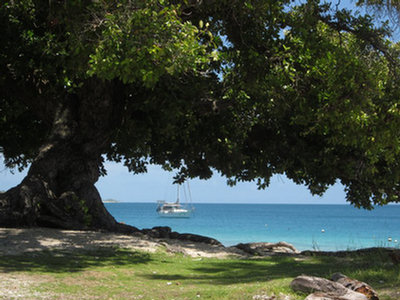
The deBrums and Capelle's are still prominent names throughout the Marshall Islands, but especially on Likiep.
So when we went ashore and met "Junior" deBrum, and James Capelle, we knew we were talking to the direct descendants of these two European traders. James and his wife Samantha keep a small store, and in the store hangs a portrait of the original Capelle, whom James still very much resembles.
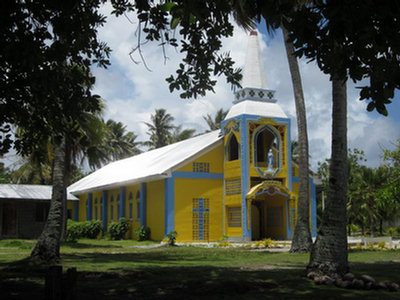
Though the descendants are thoroughly Marshallese now, the village retains just a hint of European order. We were amazed at how clean and neat everything was. We saw people regularly raking the leaves in their yards. There was none of the "Marshallese" trash that you find in Majuro and Ebeye--where every disposable item goes from hand to curb without thought of a trash can. That, combined with the thoroughly island setting, with a gorgeous beach and a nice protected anchorage, reminded me a bit of New Plymouth in the Bahamas.
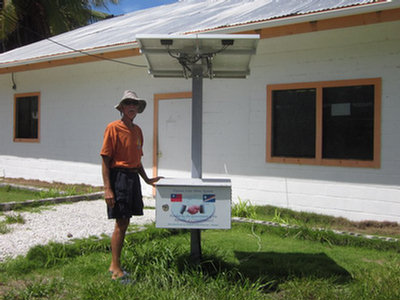
Everyone in Likiep made us feel very welcome. As we wandered around trying to find the "mayor", to present our paperwork, we first made our way to where the "internet" was. This ended up being in what looked like the school library. Here a satellite dish provided a one-computer internet connection and a telephone connection.
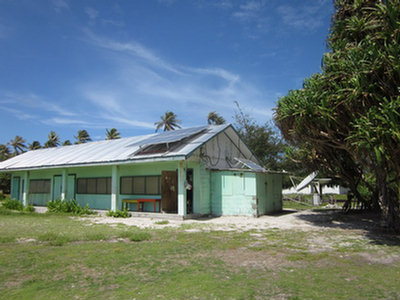
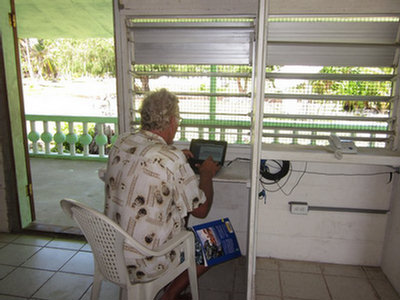
I am told that Likiep was the first outer atoll to get such service. Here we found fellow cruiser, John, from Opus, trying to check his bank balance. And here we also met Junior deBrum. Junior grew up on Likiep, speaks excellent English, and was a wealth of information. He also offered to show us where the former deBrum homestead was (mentioned as a historical place in the Lonely Planet) and the Mayor's house.
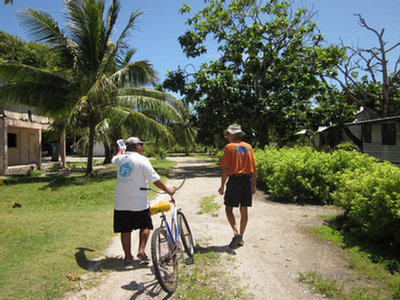
Junior is the head of the Likiep Fisheries department, and offered later to take us out to see the Giant Clam farm on a neighboring island.
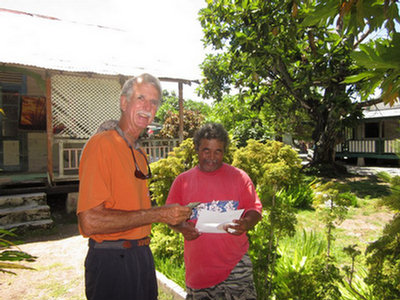
With Junior's guidance, next we met the acting Mayor of Likiep, Anthony John. (The Mayors of each village are usually in Majuro taking care of business, so visiting cruisers are usually dealing with the ACTING Mayor). We showed him our Internal Affairs permit for Likiep, and paid the $50 fee required to visit the atoll. He welcomed us to Likiep and answered a lot of our questions. And kindly took us to Capelle's store.
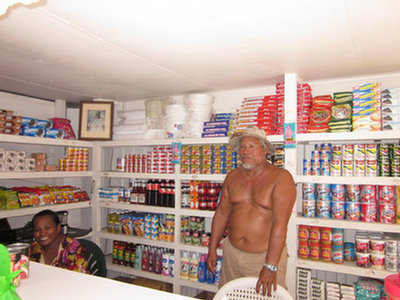
The store was open but unattended, but shortly James and his wife Samantha smilingly hustled out to say hello. The store was surprisingly well stocked for an outer-island store that only gets re-stocked every 3 months when the ship comes. Of course Dave asked if they had tomatoes or papayas and bananas, and they just laughed. Normally bananas and papayas are grown on the island, but the prolonged drought had pretty much killed everything. We bought a few items at shocking prices--a can of green beans, a $6 package of Chocolate Chip Cookies, and a package of crackers I hadn't seen before.
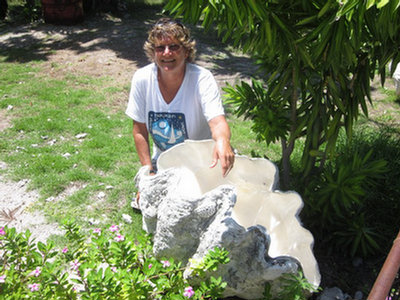
Later we sought out Joe deBrum, the operator of the Plantation Haus on the beach. He was mentioned in other cruiser accounts as being "a true friend of the cruisers". But unfortunately Joe's wife is sick, and he is in Majuro with her for the time being, though we did meet Joe's daughter and grandson, who are care-taking the hotel. The hotel isn't open anymore, as the Air Marshall Islands service to Likiep is too irregular.
As we were photographing the striking yellow church on the waterfront, we met Josef, the Catholic Priest. Later we had a chance to socialize with Josef and the two nuns who run the church, at a beach barbecue arranged by Junior deBrum. They come from other places to serve the Catholic community in Likiep--Josef is from Indonesia, and the nuns were from the Philippines.
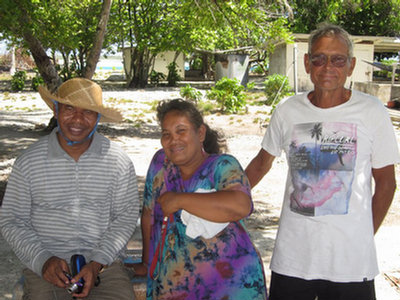
When Dave asked if there were any World War II wrecks around, Junior told him about the Japanese ship that was sunk on the reef to the SW, and the American plane that had bombed the ship, but was disabled in the attack, and landed in the water right in front of the village. Though we could find no remnants of the plane in the place Junior pointed out (right next to the wharf in front of the village), Junior recalled playing in the cockpit of the plane at low tide, when he was little. We didn't get a chance to go see the shipwreck, but a few days after we left, Junior took the crews of Westward II and Challenger out to dive on it. Stephen from Westward II told us that it was pretty broken up--interesting but not spectacular.
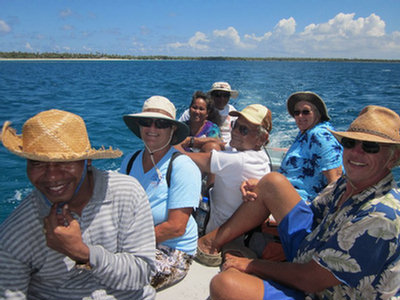
On Sunday afternoon, Junior finally come through on his promise of taking us to see the Clam Farm, and combined it with an afternoon picnic with his extended family. He loaded one launch with family and the two nuns from the church, and us and Father Josef in the other, and we motored across to the next island to the north. While our boat made a short stop on the SE point to see the Clam Farm, the other one went to the deBrum's beach camp to start meal preparations.
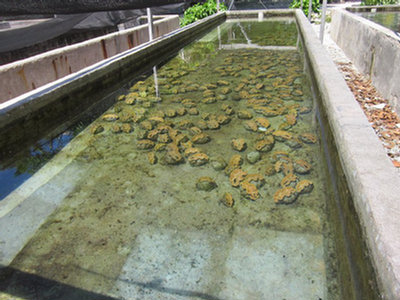
The original idea behind the Clam Farm was to re-populate the nearly extinct Giant Clams throughout the atolls. However, the lack of any regular transport between atolls has pretty much shut that idea down. Now the clams grown by Junior get shipped off to Majuro when they are about 3-6" across, and then flown to the U.S. for the aquarium market! He said his next shipment was headed for Florida!!
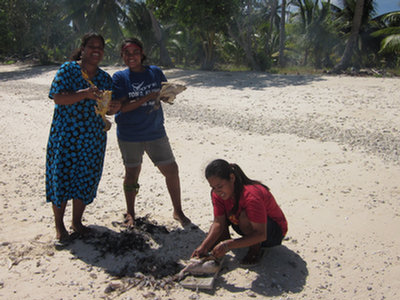
We had a great time at the "beach barbecue". Junior's wife Titi started with live fish and live chickens and a sack of rice, and fed 5 cruisers, Father Josef and the nuns, and about 10 family members, over an open fire on the beach. We had fresh coconuts to drink, and woven palm baskets to eat from. I got to watch the chicken operation from squawk to soup. But boy, are those island chickens chewy!! (The Marshallese must, conversely, think our farm-raised chicken are "soft").
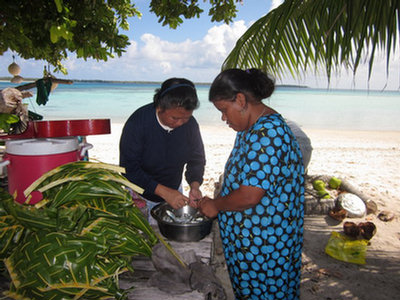
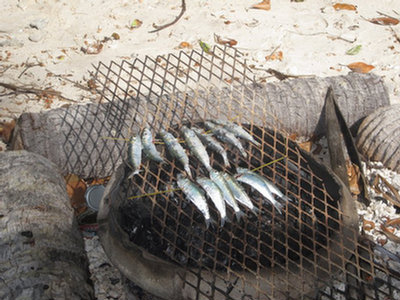
While we waited in the shade of a coconut tree for lunch to be ready, they sent a kid after drinks for the group. 2 minutes later we had fresh coconut water, complete with a straw made out of a local reed.
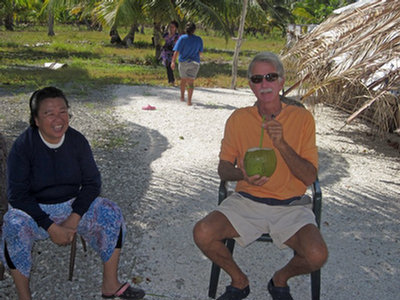
While the women were cooking the meal, the younger girls were getting the "plates" ready. In seconds they had whacked a coconut leaf and woven a plate for us, complete with coconut leaf spoon. (Though the Marshallese normally use their hands to eat, they know us visitors would prefer an implement).
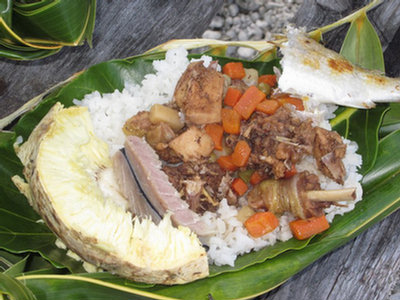
Chicken, Breadfruit, Canned Veggies, Fish, Rice
We could have spent a month in Likiep. But Dave and I had a heart to heart about cruising plans. I REALLY wanted to go see Ailuk (another 24 hour beat to the NE). Several cruisers had said it was "the best Marshallese atoll". But Dave firmly wants to spend a good bit of time--the remaining months of the summer--diving shipwrecks and exploring old Japanese bases in the atolls of Maloelap, Mili, and Jaluit. So if we wanted to go to see Ailuk, AND see what Dave wants to see, we had to get going.
So the next day, we took what looked like a decent weather window--light SE winds--to do a short overnight to Ailuk.
No comments:
Post a Comment